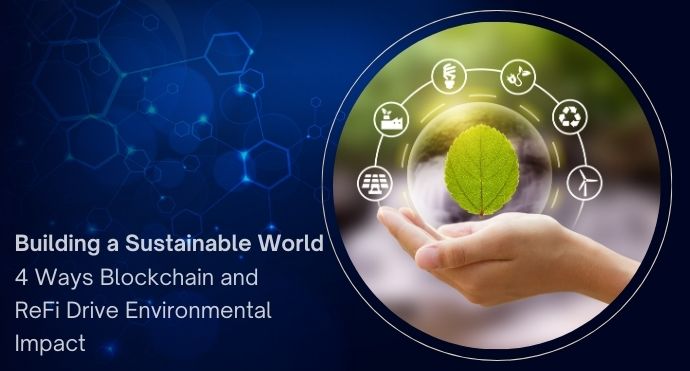As the world faces increasing environmental challenges, the need for innovative solutions becomes more critical than ever. Blockchain technology and Renewable Energy Financing (ReFi) have emerged as powerful tools that can drive environmental impact and contribute to building a sustainable future. In this article, we will explore four key ways in which blockchain and ReFi are supporting a greener world.
1. Enhancing Transparency and Traceability:
Blockchain technology provides a decentralized and immutable ledger that ensures transparency and traceability in various sectors. This transparency can be leveraged to promote sustainability across supply chains, ensuring that products and services meet stringent environmental standards. By recording every transaction and movement on the blockchain, stakeholders can verify the authenticity and sustainability of goods, reducing the risk of greenwashing and encouraging responsible consumption.
Moreover, blockchain’s traceability features enable the tracking of raw materials, carbon emissions, and waste management processes. This level of transparency allows businesses and consumers to make informed decisions, favoring eco-friendly products and supporting companies with sustainable practices.
2. Enabling Peer-to-Peer Energy Trading:
Renewable energy sources like solar and wind are gaining popularity, but the intermittent nature of these resources poses challenges for their integration into the grid. Blockchain technology addresses this issue by facilitating peer-to-peer energy trading. With blockchain-based platforms, individuals and businesses can trade surplus energy directly with one another, eliminating the need for intermediaries and maximizing the utilization of renewable resources.
This decentralized energy market not only encourages the adoption of clean energy but also empowers communities to become self-sufficient and financially benefit from their renewable energy investments. By incentivizing the generation and consumption of green energy, blockchain and ReFi contribute to a more sustainable and resilient energy infrastructure.
3. Facilitating Carbon Offset Marketplaces:
The fight against climate change requires collective efforts to reduce greenhouse gas emissions. Blockchain technology plays a crucial role in facilitating carbon offset marketplaces, where organizations can trade carbon credits. By tokenizing carbon credits on the blockchain, these marketplaces ensure transparency, security, and efficiency in carbon offset transactions.
Blockchain-based carbon offset platforms enable the tracking and verification of emission reduction projects, ensuring their legitimacy and impact. This creates an incentive for businesses to invest in emission reduction initiatives, supporting the transition to a low-carbon economy. Through blockchain and ReFi, carbon offset marketplaces contribute to mitigating climate change by encouraging sustainable practices and financing environmental projects.
4. Empowering Decentralized Renewable Energy Projects:
Traditional financing methods often pose challenges for renewable energy projects, making it difficult for smaller initiatives to secure funding. ReFi, powered by blockchain technology, revolutionizes the renewable energy financing landscape by enabling decentralized funding opportunities.
Through tokenization, blockchain-based platforms allow individuals to invest in renewable energy projects directly. This opens up new avenues for project developers to raise capital and accelerates the deployment of clean energy infrastructure. Additionally, blockchain’s transparency and smart contract capabilities ensure that investments are utilized for their intended purpose, fostering trust and accountability among stakeholders.
How blockchain and ReFi are driving environmental impact:
- In 2021, the global carbon offset market was worth $166 billion. Blockchain-based carbon offset projects are expected to grow this market by $100 billion by 2025.
- In 2022, the global sustainable finance market was worth $35 trillion. ReFi projects are expected to grow this market by $10 trillion by 2025.
- In 2023, there are over 500 ReFi projects in development. These projects are expected to have a positive impact on the environment by reducing emissions, conserving water, and protecting biodiversity.
These are just a few examples of how blockchain and ReFi are driving environmental impact. As these technologies continue to develop, we can expect to see even more innovative ways to use them to build a more sustainable world.
Here are some specific examples of how blockchain and ReFi are being used to address environmental challenges:
- Carbon offsetting: Blockchain is being used to track the purchase and sale of carbon offsets, which are credits that can be used to offset greenhouse gas emissions. This helps to ensure that carbon offsets are being used effectively and that emissions are actually being reduced.
- Sustainable agriculture: Blockchain is being used to track the supply chain for food and other agricultural products. This helps to ensure that sustainable practices are being used throughout the supply chain, from the production of the product to its delivery to the consumer.
- Renewable energy: Blockchain is being used to finance and manage renewable energy projects. This helps to make renewable energy more accessible and affordable, which can help to reduce our reliance on fossil fuels.
- Water conservation: Blockchain is being used to track water usage and manage water resources. This helps to ensure that water is used efficiently and that water shortages are avoided.
- Biodiversity conservation: Blockchain is being used to track the sale of wildlife products and to monitor the status of endangered species. This helps to protect wildlife and prevent the illegal trade of endangered species.
Conclusion:
Blockchain technology and ReFi are transforming the way we approach sustainability and environmental conservation. By enhancing transparency, enabling peer-to-peer energy trading, facilitating carbon offset marketplaces, and empowering decentralized renewable energy projects, these innovative solutions are driving positive environmental impact.
As we celebrate World Environment Day, it is crucial to recognize the potential of blockchain and ReFi in building a sustainable world. By embracing these technologies and supporting initiatives that leverage their power, we can pave the way for a greener and more resilient future. Together, we can harness the potential of technology and finance to create lasting environmental change.



